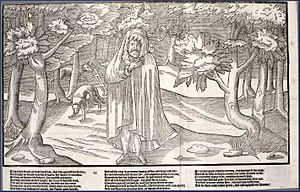Rory O'More facts for kids
Rory O'More, also known as Rory Oge O'More (Irish: Ruairí Óg Ó Mórdha), was an important Irish lord. He lived in the 1500s and died in 1578. His land was in an area that later became Laois in Ireland. Rory O'More was known for often fighting against English rule in Ireland.

Contents
Who Was Rory O'More's Family?
Rory O'More was the second son of Ruairí Ó Mórdha, who was the Captain of Leix. His mother was Margaret Butler. His family were the leaders, or Chiefs, of one of the most important Irish clans, the O'Mores.
His father, Ruairí Caoch Ó Mórdha, was a strong leader. When Rory's grandfather, Connell Ó Mórdha, died in 1537, there was a disagreement over who should lead the family. The English Lord Deputy of Ireland, Lord Leonard Grey, got involved. Eventually, Rory's father, Ruairí, became the leader.
In 1542, Rory's father, Ruairí Caoch, agreed to a process called "surrender and regrant." This meant he gave his land to the English King and then received it back, but under English law. However, by 1550, an order said that no one from the Ó Mórdha family could own land in Leix. Rory's father was killed sometime between 1550 and 1557.
How Did English Rule Change Laois?
In 1556, Queen Mary passed a law that gave the English Crown control over areas like Leix and Offaly. These areas then became new counties: Queen's County (now County Laois) and King's County (now County Offaly). This action took land away from the O'More clan and started the Plantations of Ireland, where English settlers moved onto Irish lands.
Rory's Sons: Ruairí Óge and Callagh
Rory O'More had two sons: Callagh and Ruairí Óge. Callagh grew up in England and was known as 'The Calough'. He even studied law there. In 1574, he was given land in Ireland. Callagh's son, Rory O'Moore, later became a leader in the Irish Rebellion of 1641.
Ruairí Óge Ó Mórdha, Rory's second son, was often involved in fighting against English rule.
Rory O'More's Rebellions
Ruairí Óge was constantly rebelling. He received a pardon in 1566, but by 1571, he was seen as a dangerous person. In 1572, he was fighting against the Earl of Ormond and Queen Elizabeth's forces. He was helped by the small number of English soldiers in the area.
When the Earl of Desmond escaped from Dublin in November 1572, Ruairí Óge Ó Mórdha helped him. He guided him through Kildare and protected him in Laois. Ruairí Óge was captured by the English in November 1574 but quickly escaped.
Sir Henry Sidney, an important English official, called O'Mordha "an obscure and base varlet." In 1575, Sidney wrote that Rory Oge O'More controlled Queen's County, taking what he wanted and destroying what he pleased.
Submission and Continued War
In December 1575, when Sidney came to his territory, O'Mordha met him in Kilkenny Cathedral. He said he was sorry for his past actions and promised to behave better. He was given another pardon in June 1576.
However, a terrible event happened on New Year's Day 1577. Many Irish clan leaders and their families from Laois and Offaly were invited to a peace meeting at Mullaghmast in County Kildare. They arrived without weapons. But Sir Henry Sidney's troops surrounded the castle and killed them all. Estimates say between 40 and hundreds of people died.
O'Mordha was very angry and promised to get revenge for his relatives' deaths. He kidnapped two Englishmen who were related to important people. He hoped for help from Spain and allied with the Clan O'Connor. They gathered an army.
In March 1577, the English ordered an attack on Ruairí Óg and the Clan O'Connor. But in the same month, the O'More and O'Connor clans got their revenge for Mullaghmast. They raided the Pale, an area controlled by the English. Sidney wrote that "Rory Oge O'More and Cormock M'Cormock O'Conor have burnt the Naas. They ranne thorough the towne lyke hagges and furies of hell, with flakes of fier fastned on poles ends."
Rory O'More's Death
The Queen's agents offered a huge reward of £1,000 for Rory O'More, which was a lot of money at the time. This was a common way for them to deal with Irish clan chiefs who resisted. In June 1578, members of the Fitzpatrick family killed Rory O'More.
Rory O'More's Descendants
Rory O'More had a son named Eoghan mac Ruairí Ó Mórdha. Eoghan was taken care of by John Burke, the son of the Earl of Clanricarde. The English eventually captured Eoghan, but he later returned and got back almost all of Laois. He was killed in a fight near Timahoe on August 17, 1600.
After Eoghan's death, the O'Mores as an Irish clan faced great difficulties. Colonel Rory O'More (c.1620-c.1653), who helped organize the Irish Rebellion of 1641, was Rory O'More's nephew.
Today, the only surviving descendants of the O'More family are from the "house of More O'Ferrall." The title of "Lord of Laois" has been passed down through Rory O'More's descendants. The current head of the More O'Ferralls holds this title. They also hold the title of "Prince of Annally."
Family Tree
Melaghlin mac Owny mac Gilla Padraigh Ó Mórdha, died 1502. | |____________________________________________________________________________________ | | | | Connell Ó Mórdha (died 1537) Pierce/Peter an Tainiste, fl. 1537. | |________________________________________________________________________________________________________ | | | | | | | | | | Lysaght (d. 1541?) Kedagh Roe (d. 1542) Ruairí Caoch Ó Mórdha, fl. 1554. Gilla Padraigh Connell Óge, d. 1557. | =Margaret Butler d. 1548. | | Kedagh/James? |____________________________ fl. 1584? | | | | Ruairí Óge, d. 1578. Calvagh/Callagh of Ballina, d. 1618. =? =Margaret Scurloug | | | |__________________________________________________ Uaithne (Owney), d. 1600. | | | | | | | | Rory O'More Lysaght Margaret dau. =Jane Barnewall (issue) (issue) (issue) (issue)

